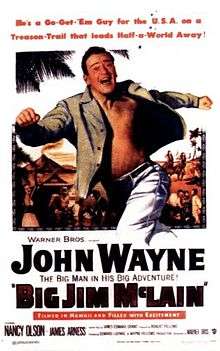Big Jim McLain
| Big Jim McLain | |
|---|---|
 | |
| Directed by | Edward Ludwig |
| Produced by |
Robert M. Fellows John Wayne |
| Written by |
Richard English (story) James Edward Grant Eric Taylor |
| Starring |
John Wayne Nancy Olson James Arness Alan Napier Veda Ann Borg |
| Music by |
Paul Dunlap Arthur Lange Emil Newman |
| Cinematography | Archie J. Stout |
| Edited by | Jack Murray |
| Distributed by | Warner Bros. |
Release dates |
|
Running time | 90 min. |
| Country | United States |
| Language | English |
| Box office | $2.6 million (US rentals)[1] |
Big Jim McLain is a 1952 Film Noir political thriller film starring John Wayne and James Arness as HUAC investigators hunting down communists in the post-war Hawaii organized labor scene. Edward Ludwig directed.
This was the first film in which Wayne played a contemporary law enforcement officer, instead of an Old West lawman. Near the end of his career, in the mid-1970s, he took on two more such roles, each time playing an urban cop.
Plot
House Un-American Activities Committee investigators Jim McLain (John Wayne) and Mal Baxter (James Arness) come to Hawaii to track American Communist Party activities. They are interested in everything from insurance fraud to the sabotage of a U.S. naval vessel.
After receiving useful information from reporter Phil Briggs (Vernon "Red" McQueen), the agents begin searching for Willie Nomaka, a former Party Treasurer, who allegedly experienced a nervous breakdown and has been seeing psychiatrist Dr. Gelster (Gayne Whitman). The doctor's secretary, Nancy Vallon (Nancy Olson), is helpful as well. A widow, McLain asks her on a date and a romance develops.
Nomaka's landlady, Madge (Veda Ann Borg), assists in the investigation, flirting with McLain. Nomaka's ex-wife (Madame Soo Yong) also helps McLain. Nomaka is eventually found to be staying in a sanitorium, heavily drugged and unable to speak. Party leader Sturak (Alan Napier) gives orders to Dr. Gelster to get rid of him. Gelster also kills McLain's partner Baxter, by mistake, when he succumbs to an injection of truth serum.
As the investigators close in, Sturak attempts to make Gelster confess to his Party membership so the case can be closed and so others can continue their nefarious work. Their meeting is interrupted by McLain, who instigates a brawl. Police arrive to place Party leaders under arrest, but ultimately he and Nancy Vallon see them plead the Fifth Amendment and go free.
Cast
- John Wayne as Jim McLain
- James Arness as Mal Baxter
- Nancy Olson as Nancy Vallon
- Alan Napier as Sturak
- Vernon "Red" McQueen as Phil Briggs
- Gayne Whitman as Dr. Gelster
- Veda Ann Borg as Madge
- Robert Keys as Edwin White
Production notes
- The film was shot entirely on location in Hawaii and includes scenes of Pearl Harbor, Molokai, Waikiki and Honolulu 30 April- 16 June 1952.
- Several of the people cast in the film were Honolulu citizens: Honolulu Chief of Police Dan Liu, news reporter Vernon "Red" McQueen, wrestling champion Zinko "Lucky" Simunovich, University of Hawaii professor Joel Trapido, Bishop Kinai Ikuma, Sam "Steamboat" Mokuaki, Charles "Panama" Baptiste, Rennie Brooks, Akira Fukunaza and Ralph Honda.
- World Premiere was in Kohio, Hawaii on 28 August 1952.
- The film was rushed into release to beat two other John Wayne films, RKO's Jet Pilot, which was not released until 1957, and Republic's The Quiet Man.
- After the opening credits, a voice-over narrator recites quotes from the short story "The Devil and Daniel Webster" by Stephen Vincent Benet, immediately followed by a voice-over tribute to the House Committee on Un-American Activities for its pursuit of inquiries "undaunted by the vicious campaign of slander launched against them.
- A title card at the end of the film states that the incidents in the film were based on the files of the Committee, although names and places were changed, and acknowledges the cooperation of the Committee in the making of the film.
- Nancy Olson hated the script but figured that six weeks in Hawaii and a chance to work with a star like John Wayne seemed a good enough reason to accept. She thought the film would flop and nobody would see it. She was right to a degree - it wasn't one of Wayne's more successful pictures - but she didn't count on how often it would appear on TV. She later said people stopped her all the time to mention it. Olson, a staunch liberal Democrat, said she and Wayne would often have political arguments but she would always let Wayne have the last word.
- John Wayne recorded an advertisement for Camel cigarettes on the set.
- The film has developed something of a cult following due to a perceivedly now-campy red scare theme. In some European markets the film was retitled as Marijuana and dispensed with the communist angle, making the villains drug dealers instead. This was achieved entirely through script changes and dubbing.
- The film's publicity slogan was: "He's A Go-Get-'Em Guy for the U.S.A. on a Treason Trail That Leads Half-a-World Away!"
See also
References
- ↑ 'Top Box-Office Hits of 1952', Variety, January 7, 1953
External links
| Wikimedia Commons has media related to Big Jim McLain. |
- Big Jim McLain at the Internet Movie Database
- Big Jim McLain at AllMovie
- Big Jim McLain at the TCM Movie Database